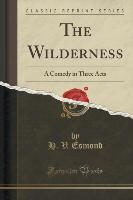Read more
Excerpt from The Wilderness: A Comedy in Three Acts
Scene. - Fashionable tea-rooms in Bond Street. A large room at back opening on to balcony, overlooking the street. Near the centre of the stage an arch, and the lower tea-room, in the front. Tea-tables everywhere. A band somewhere at the back playing at intervals during the Act. The maids are smart, lady-like girls. At the table to the right, in the lower room nearest the audience, are seated Lady Honoria Pawson and her son Gilbert Pawson. Lady Honoria is a funereal remnant of past splendor. Her son Gilbert is about forty-five and has lived too well; he is short, fat and bilious. Two maids are in the act of setting tea and muffins before them when the curtain rises. Many of the tables are empty, a few are occupied; during the Act all the tables fill, and occasionally the chatter is so general that pauses occur in the principal dialogue.
Lady H. (ferreting a handkerchief out of a small bag at her large waist) That was Sir Charles at the corner table.
Mr. Gilbert. (puffily eating) No, it wasn't; it was Worburn the brewer.
Lady H. (powdering her nose, then pulling her veil over it) It wasn't; it was Sir Charles.
Mr. Gilbert. It was Worburn. I lunched with him to-day.
Lady H. (returning her handkerchief to her bag and shutting it with a snap) It was Sir Charles. I bowed to him.
Mr. Gilbert. Worburn don't mind, he's accustomed to it.
Lady H. I never forget a face. I've a royal memory. Gilbert, you're getting stouter.
Mr. Gilbert, (in a huff) Whenever I disagree with you, you say I am stouter.
About the Publisher
Forgotten Books publishes hundreds of thousands of rare and classic books. Find more at www.forgottenbooks.com
This book is a reproduction of an important historical work. Forgotten Books uses state-of-the-art technology to digitally reconstruct the work, preserving the original format whilst repairing imperfections present in the aged copy. In rare cases, an imperfection in the original, such as a blemish or missing page, may be replicated in our edition. We do, however, repair the vast majority of imperfections successfully; any imperfections that remain are intentionally left to preserve the state of such historical works.

